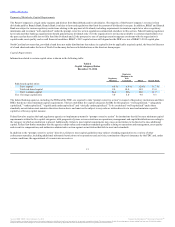BB&T 2014 Annual Report Download - page 24
Download and view the complete annual report
Please find page 24 of the 2014 BB&T annual report below. You can navigate through the pages in the report by either clicking on the pages listed below, or by using the keyword search tool below to find specific information within the annual report.
Table of Contents
Further downgrades of U.S. government securities by one or more of the credit ratings agencies could have a material adverse effect on BB&T’s operations,
earnings and financial condition.
In 2011, the S&P credit rating agency lowered its long term sovereign credit rating on the United States from AAA to AA+, which reflected S&P’s view that
an August 2011 agreement of U.S. lawmakers regarding the debt ceiling fell short of what would be necessary to stabilize the U.S. government’s medium term
debt dynamics. In June 2013, S&P reaffirmed that rating, while raising its outlook from “Negative” to “Stable.” The three other major credit rating agencies
did not downgrade their previously issued U.S. sovereign credit ratings, though some have issued negative outlooks at various times over the last several
years. While the risk of a sovereign credit ratings downgrade of the U.S. government, including the rating of U.S. Treasury securities, has been reduced, the
possibility still remains. It is foreseeable that the ratings and perceived creditworthiness of instruments issued, insured or guaranteed by institutions or
agencies directly linked to the U.S. government could also be correspondingly affected by any such downgrade. Instruments of this nature are key assets on
the balance sheets of financial institutions, including BB&T, and are widely used as collateral by financial institutions to meet their day-to-day cash flow
needs in the short-term debt market.
A possible future downgrade of the sovereign credit ratings of the U.S. government and a decline in the perceived creditworthiness of U.S. government-
related obligations could impact BB&T’s ability to obtain funding that is collateralized by affected instruments, as well as affect the pricing of that funding
when it is available. A downgrade may also adversely affect the market value of such instruments. BB&T cannot predict if, when or how any changes to the
credit ratings or perceived creditworthiness of these organizations will affect economic conditions. Such ratings actions could result in a significant adverse
impact on BB&T. For example, BB&T’s securities portfolio consists largely of MBS issued by GSEs, such as FHLMC and FNMA. Among other things, a
further downgrade in the U.S. government’s credit rating could adversely impact the value of these securities and may trigger requirements that the Company
post additional collateral for trades relative to these securities. A downgrade of the sovereign credit ratings of the U.S. government or the credit ratings of
related institutions, agencies or instruments would significantly exacerbate the other risks to which BB&T is subject and any related adverse effects on the
business, financial condition and results of operations.
The soundness of other financial institutions could adversely affect BB&T.
Financial services institutions are interrelated as a result of trading, clearing, counterparty, or other relationships. BB&T has exposure to many different
industries and counterparties, and BB&T and certain of its subsidiaries routinely execute transactions with counterparties in the financial services industry,
including brokers and dealers, commercial banks, investment banks, mutual and hedge funds and other institutions. Many of these transactions expose
BB&T to credit risk in the event of default of its counterparty. In addition, BB&T’s credit risk may be exacerbated when collateral is liquidated at prices not
sufficient to recover the full amount of the loan or derivative exposure. These types of losses could materially and adversely affect BB&T’s results of
operations or financial condition.
The expiration of the loss sharing agreements related to the Colonial acquisition could result in increased losses on loans and securities.
In connection with its acquisition of Colonial, BB&T entered into loss sharing agreements with the FDIC, which provided that a significant portion of losses
related to the acquired loan portfolios would be borne by the FDIC. Effective October 1, 2014, loans and securities subject to the commercial loss sharing
agreement with the FDIC were no longer covered by loss sharing. These loans and securities totaled $561 million and $1.2 billion, respectively, as of
December 31, 2014.
Additionally, the single family loss sharing agreement ends in 2019. Any charge-off of related losses that BB&T experiences after the term of the single
family loss sharing agreement will not be reimbursed by the FDIC and will negatively impact BB&T’s net income.
Liquidity Risk
BB&T’s liquidity could be impaired by an inability to access the capital markets, an unforeseen outflow of cash or a reduction in the credit ratings for
BB&T or its subsidiaries.
Liquidity is essential to BB&T’s businesses. When volatility or disruptions occur in the capital markets, BB&T’s ability to access capital could be materially
impaired. Additionally, other factors outside of BB&T’s control, such as a general market disruption or an operational problem that affects third parties, could
impair BB&T’s ability to access capital markets or create an unforeseen outflow of cash or deposits. BB&T’s inability to access the capital markets could
constrain its ability to make new loans, to meet its existing lending commitments and ultimately jeopardize its overall liquidity and capitalization.
23
Source: BB&T CORP, 10-K, February 25, 2015 Powered by Morningstar® Document Research℠
The information contained herein may not be copied, adapted or distributed and is not warranted to be accurate, complete or timely. The user assumes all risks for any damages or losses arising from any use of this information,
except to the extent such damages or losses cannot be limited or excluded by applicable law. Past financial performance is no guarantee of future results.
























